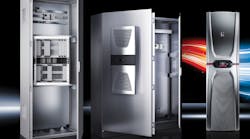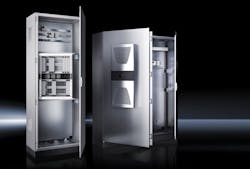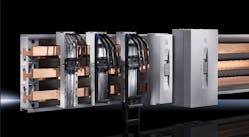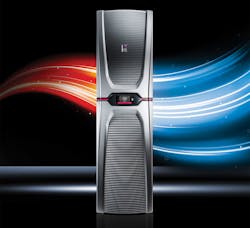Often when designers and engineers think of an enclosure, it’s simply as the last item on a long list. After all, its purpose is “just” to house the controls. Because of this misperception, when there’s a failure in the controls, it’s often because the design of enclosure did not account for the necessary level of cooling, power distribution, or security.
Rethinking enclosures is actually another opportunity to improve the overall system design. Regardless of the application or environment, it can usually be improved with some innovative thinking and using the latest manufacturing techniques to protect equipment, save space, and reduce costs.
An enclosure has two basic tasks: housing and protecting sensitive electrical equipment from environmental contaminants and weather.
Enclosures have volume and take up valuable space for factory floors. Right-sizing your enclosure makes them simpler and easier to install and work with.
But what separates a run-of-the-mill enclosure from a top-notch one? The answer is found in the ability to reduce the total cost of ownership. Here are 10 areas to consider when your goal is to have an enclosure that will keep your business running, both now and in the future:
Materials. Although modern enclosures can be made from many different materials (fiberglass, polycarbonate, etc.), most are comprised of carbon or stainless steel. Stainless steel is especially popular for its durability and corrosion resistance. However, not every application calls for the extra weight and cost of an all-steel enclosure. Considering non-metallic materials is a good practice when designing or specifying an enclosure where weight is a critical factor.
Protection. An enclosure’s integrity corresponds to its NEMA protection rating.
Type 1: Rated for indoors. Delivers a degree of protection against access to hazardous parts and ingress of solid foreign objects (falling dirt).
Type 3R: Rated for indoors or outdoors; rainproof. Provides a degree of protection against access to hazardous parts and ingress of water (rain, snow and sleet).
Type 12: Rated for indoors; sealed against dust, dirt, and dripping water. Delivers a degree of protection against access to hazardous parts.
Type 4: Sealed against dust, dirt, and sprayed water. Provides a degree of protection against access to hazardous parts. Will be undamaged by the external formation of ice.
4x: Adds corrosion resistance to Type 4.
Closely consider the environment the enclosure will be placed in as well as the application the system is being designed for.
Busbar modularity allows for simple, tool-free electrical connections and protection from contact hazards while using space efficiency.
Security. Physical security is often neglected, but it’s the most important design goal for most enclosures, whether outdoor or indoor. Ideally an enclosure should be as difficult to access as your own office. To this end, enclosures should incorporate padlockable or key lockable handles, remote monitoring, remote access, and other security features.
Safety. Keeping workers and equipment safe is always a prime consideration. After all, the main purpose of the enclosure is protection. You can protect against arc flashes and associated hazards by using disconnect enclosures which are designed so that power must be shut off before the enclosure is opened. Other safety design strategies can include access ports and viewing windows that allow for data collection and monitoring without opening the enclosure door.
Load-bearing. Does the enclosure really need to be made of heavy-gauge steel? In modern enclosures, the strength is in the frame, often sparing users the cost of thick-skinned and all-welded construction. Most frames today support well over 3,000 lb without factoring in exterior panels, roof, or walls.
Size. Contrary to two-dimensional depictions, enclosures aren’t just a mounting panel and a door; they have volume and take up valuable space on factory floors. Right-sizing your enclosure will make it much simpler to install and much easier to work with. Reducing your enclosure’s footprint will also save space and reduce transportation and freight costs.
Climate control. Efficiently managing heating and cooling loads within the enclosure lets factory owners protect the controls and electronics inside while meeting the demand for reduced energy consumption. Climate control options for enclosures include:
Air cooling (fans and heat exchangers)
Cooling units (thermoelectric coolers)
Liquid cooling (chillers)
Enclosure heaters
To improve thermal management in enclosures, add accessories such as thermostats, hygrostats, filters, water distribution, and air routing.
Efficiently managing heating and cooling loads protects controls and electronics while increasing efficiency. Rittal’s Blue e+ cooling units use an innovative hybrid process for active heating and cooling.
Future-proofing. Consider the hidden costs associated with electrical enclosures, including extra labor and material resources that increase the total cost of ownership when new equipment or upgrades are added over time. These are the changes many designers don’t consider until they have to scale up, convert to other NEMA ratings, or add panels. You can make sure your design is scalable by accounting for these and other factors early on.
Power. Electrical busbars are becoming increasingly popular for safe installations and troubleshooting for high-current power distribution. Busbars’ modularity allows for simple, tool-free connections for components and protection from contact hazards. Housed inside switchgear and controls, busbars also contribute to greater space efficiency within the enclosure.
Accessories. Engineer are always looking for better ways to accomplish tasks and reduce costs. For example, could LED lighting improve ease of use while lowering electrical bills? Accessories can also customize enclosures, such as adding an HMI for quick overviews, or a viewing door for easier I/O monitoring and troubleshooting.
By considering protection, ease of use, and total cost of ownership at the outset, engineers can ensure enclosure designs are not only functional, but exceptional.
Troy Miesse works at Rittal North America LLC. If you have any questions regarding enclosures, contact Rittal at (800) 477-4000, or visit rittal.us.




